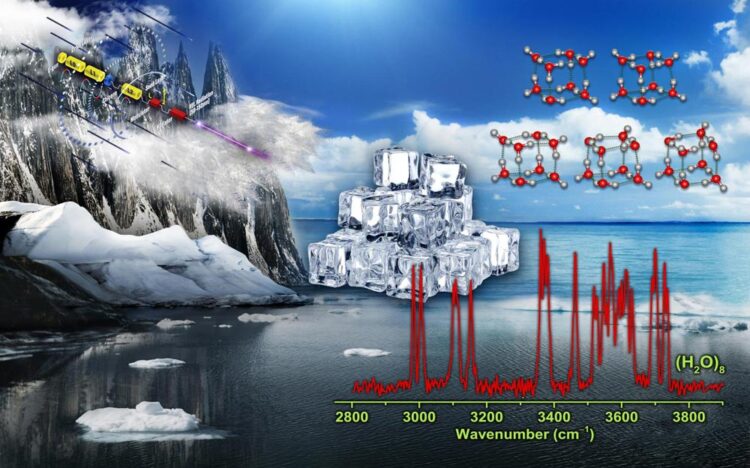Scientists discover new structures in the smallest ice cube

Scientists discovered new structures in the smallest ice cube.
Credit: LI Gang and LI Qinming
The freezing of water is one of the most common processes. However, understanding the microstructure of ice and its hydrogen-bonding networks has been a challenge.
The low-energy structure of water octamer is predicted to be nominally cubic, with eight tri-coordinated water molecules at the eight corners of the cube. Such tri-coordinated water molecules have been identified at the surface of ice.
Only a few gas-phase studies have been achieved for experimental characterization of water octamer, and two nearly isoenergetic structures with D2d and S4 symmetry are found.
This understanding now has been changed. A research team led by Prof. JIANG Ling and Prof. YANG Xueming from the Dalian Institute of Chemical Physics (DICP) of the Chinese Academy of Sciences, in collaboration with Prof. LI Jun from Tsinghua University, revealed the coexistence of five cubic isomers in the smallest ice cube, including two with chirality.
The study was published in Nature Communications on October 28.
Prof. JIANG and Prof. YANG developed a method of infrared spectroscopy of neutral clusters based on a tunable vacuum ultraviolet free electron laser (VUV-FEL). This method created a new paradigm for the study of vibrational spectra of a wide variety of neutral clusters that could not be studied before.
“We measured infrared spectra of size-selected neutral water octamer using the VUV-FEL-based infrared scheme,” said Prof. JIANG.
“We observed the distinct features in the spectra, and identified additional cubic isomers with C2 and Ci symmetry, which coexisted with the global-minimum D2d and S4 isomers at finite temperature of the experiment,” said Prof. YANG.
Prof. LI’s team conducted quantum chemical studies to understand the electronic structure of the water octamer. They found that the relative energies of these structures reflect topology-dependent, delocalized multi-center hydrogen-bonding interactions.
The study demonstrated that even with a common structural motif, the degree of cooperativity among the hydrogen-bonding network created a hierarchy of distinct species. It provided crucial information for fundamental understanding of the formation processes of cloud, aerosol, and ice, especially under rapid cooling.
Their findings provide a benchmark for accurate description of the water intermolecular potentials to understand the macroscopic properties of water, and stimulate further study of intermediate-ice structures formed in the crystallization process of ice.
All latest news from the category: Life Sciences and Chemistry
Articles and reports from the Life Sciences and chemistry area deal with applied and basic research into modern biology, chemistry and human medicine.
Valuable information can be found on a range of life sciences fields including bacteriology, biochemistry, bionics, bioinformatics, biophysics, biotechnology, genetics, geobotany, human biology, marine biology, microbiology, molecular biology, cellular biology, zoology, bioinorganic chemistry, microchemistry and environmental chemistry.
Newest articles

Ion thermoelectric conversion devices for near room temperature
The electrode sheet of the thermoelectric device consists of ionic hydrogel, which is sandwiched between the electrodes to form, and the Prussian blue on the electrode undergoes a redox reaction…

Zap Energy achieves 37-million-degree temperatures in a compact device
New publication reports record electron temperatures for a small-scale, sheared-flow-stabilized Z-pinch fusion device. In the nine decades since humans first produced fusion reactions, only a few fusion technologies have demonstrated…

Innovative microscopy demystifies metabolism of Alzheimer’s
Researchers at UC San Diego have deployed state-of-the art imaging techniques to discover the metabolism driving Alzheimer’s disease; results suggest new treatment strategies. Alzheimer’s disease causes significant problems with memory,…





















